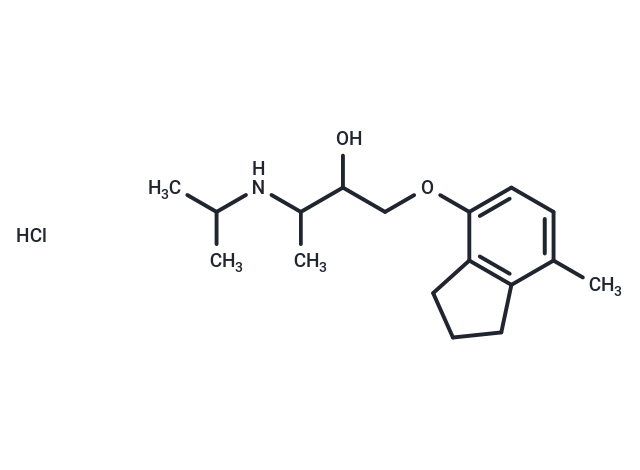Shopping Cart
Remove All Your shopping cart is currently empty
Your shopping cart is currently empty
ICI-118551 Hydrochloride (ICI-118,551) is a highly selective β2-adrenergic receptor antagonist with Ki values of 0.7, 49.5 and 611 nM for β2, β1 and β3 receptors, respectively.

| Pack Size | Price | USA Warehouse | Global Warehouse | Quantity |
|---|---|---|---|---|
| 1 mg | $195 | In Stock | In Stock | |
| 5 mg | $483 | In Stock | In Stock | |
| 10 mg | $692 | - | In Stock | |
| 25 mg | $1,080 | - | In Stock | |
| 50 mg | $1,490 | - | In Stock | |
| 100 mg | $1,970 | - | In Stock |
| Description | ICI-118551 Hydrochloride (ICI-118,551) is a highly selective β2-adrenergic receptor antagonist with Ki values of 0.7, 49.5 and 611 nM for β2, β1 and β3 receptors, respectively. |
| Targets&IC50 | β2-adrenoceptor:0.7nM(Ki), β3-adrenoceptor:611nM(Ki), β1-adrenoceptor:49.5nM(Ki) |
| In vitro | ICI-118551 inhibits cAMP accumulation by 50% (IC50 = 1.7 mM)[1]. Pharmacological experiments proves that the right shift of the norepinephrine dose-response curve by ICI 118551 is mediated via a beta(2)-adrenoceptor/G(i/o) protein-dependent pathway enhancing NO production in the endothelium; these results are corroborated in beta-adrenoceptor and endothelial NO synthase knockout mice where ICI 118551 has no effect. ICI 118551 increases vascular lumen diameter in lung sections and reduces pulmonary arterial pressure under normoxia and under hypoxia in the isolated perfused lung model[2]. Transgenic mice with high beta(2)AR number and increased G(i) levels have normal basal contractility but show a similar negative inotropic response to ICI 118,551. Overexpression of human beta(2)AR in rabbit myocytes using adenovirus potentiates the negative inotropic effect of ICI 118,551. In human, rabbit, and mouse myocytes, the negative inotropic effects are blocked after treatment of cells with pertussis toxin to inactivate G(i), and overexpression of G(i)alpha(2) induces the effect de novo in normal rat myocytes[5]. |
| In vivo | After 1 week of treatment, ICI 118,551 has no effect on the beta 1-receptor mediated shortening of electromechanical systole (QS2I), the rise in systolic pressure and rise in renin, whereas these responses are blocked by a dose factor of eight after propranolol. ICI 118,551 and propranolol equally block the beta 2-receptor mediated fall in diastolic pressure and the rise in noradrenaline. beta 2-selective blockade by ICI 118,551 lowers blood pressure[4]. |
| Cell Research | Binding reactions are carried out by incubating 60 μg of membranes with 10 nM [3H]dihydroalprenolol hydrochloride and different concentrations of ICI 118,551. After a two hour incubation at room-temperature, the binding reactions are terminated by rapid filtration over glass fiber filters. Radioactivity in the filters is then quantified using a liquid scintillation counter. Non-specific binding is determined in the presence of 1 μM alprenolol. Binding data are analyzed with GraphPad Prism software. (Only for Reference) |
| Synonyms | (Rac)-ICI-118551 hydrochloride |
| Molecular Weight | 313.86 |
| Formula | C17H27NO2·HCl |
| Cas No. | 1217094-53-5 |
| Smiles | Cl.CC(C)NC(C)C(O)COc1ccc(C)c2CCCc12 |
| Relative Density. | no data available |
| Storage | Powder: -20°C for 3 years | In solvent: -80°C for 1 year | Shipping with blue ice/Shipping at ambient temperature. | ||||||||||||||||||||||||||||||
| Solubility Information | Ethanol: 27 mg/mL (86.03 mM), Sonication is recommended. H2O: 19 mg/mL (60.54 mM), Sonication is recommended. DMSO: 58 mg/mL (184.8 mM), Sonication is recommended. | ||||||||||||||||||||||||||||||
Solution Preparation Table | |||||||||||||||||||||||||||||||
H2O/Ethanol/DMSO
| |||||||||||||||||||||||||||||||
| Size | Quantity | Unit Price | Amount | Operation |
|---|

Copyright © 2015-2025 TargetMol Chemicals Inc. All Rights Reserved.